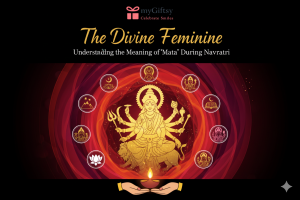
Navratri, the nine-night festival, is a vibrant celebration of the divine feminine. At the heart of this celebration is the word “Mata,” which translates to “Mother.” But in the context of Navratri, “Mata” is more than just a word—it’s a profound concept that embodies the very essence of creation, power, and protection.
Let’s break down the meaning of “Mata” during Navratri, step by step.
Step 1: The Cosmic Mother – ‘Adi Shakti’
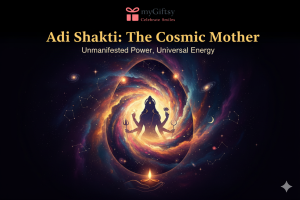
Before we even get to the nine forms of the Goddess, it’s crucial to understand the fundamental concept of ‘Mata’ as ‘Adi Shakti’—the primordial, ultimate power. This is the unmanifested, universal energy from which everything originates. ‘Adi Shakti’ is the creative force that brings the cosmos into existence. In this sense, ‘Mata’ is not a physical being but the divine cosmic energy that permeates all of reality.
This is why Navratri is celebrated as a period of profound spiritual significance. It’s a time to connect with this primal energy, to recognize the power that resides not just in the deities, but within each of us.
Step 2: The Three Primary Manifestations – Tridevi
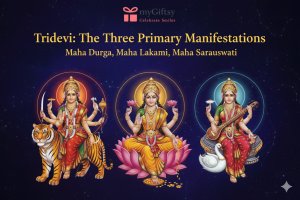
The festival of Navratri is divided into three sets of three nights, each dedicated to a different manifestation of the ‘Mata.’ These three goddesses—Durga, Lakshmi, and Saraswati—represent the three primary aspects of the divine feminine and are the core of the Navratri celebrations.
- Mata Durga (The Goddess of Power and Protection): The first three days are dedicated to Durga. The name “Durga” means “the one who eliminates suffering.” She is the warrior goddess, fierce and powerful, who vanquishes evil and protects her devotees. In this form, ‘Mata’ represents strength, courage, and the ability to overcome all obstacles. Worshipping Durga is a way of invoking inner strength to fight our own inner demons and negative tendencies.
- Mata Lakshmi (The Goddess of Wealth and Prosperity): The middle three days are for Lakshmi. She is the goddess of abundance, not just in terms of material wealth, but also spiritual prosperity, good fortune, and well-being. Worshipping Lakshmi is about invoking a sense of richness in all aspects of life—health, relationships, knowledge, and inner peace. ‘Mata’ as Lakshmi teaches us that true wealth is holistic and balanced.
- Mata Saraswati (The Goddess of Knowledge and Wisdom): The final three days are dedicated to Saraswati. She is the embodiment of knowledge, arts, music, and wisdom. She represents the highest form of enlightenment and intellectual pursuits. Worshipping Saraswati is a celebration of the human mind’s capacity for learning and creativity. ‘Mata’ in this form inspires us to seek knowledge and use it for the betterment of ourselves and society.
Step 3: The Nine Forms – Navadurga
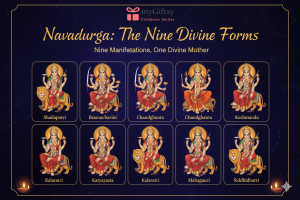
During Navratri, devotees honor nine specific forms of Durga, known as the ‘Navadurga.’ Each of these forms represents a different aspect of the Divine Mother’s power and compassion. Worshipping them sequentially allows for a deeper and more personal connection.
- Shailaputri: The daughter of the mountains, representing strength and devotion.
- Brahmacharini: The unmarried ascetic, symbolizing austerity and penance.
- Chandraghanta: The goddess with a half-moon on her forehead, signifying peace and courage.
- Kushmanda: The creator of the universe, representing the cosmic egg.
- Skandamata: The mother of Lord Skanda, symbolizing motherhood and protection.
- Katyayani: The warrior goddess, fierce and protective of her devotees.
- Kalaratri: The dark night, representing the destroyer of ignorance and darkness.
- Mahagauri: The pure and fair goddess, symbolizing purity and serenity.
- Siddhidhatri: The giver of supernatural powers, representing the ultimate fulfillment of desires.
Each of these forms is a unique expression of the same divine ‘Mata,’ showing us that divinity is multifaceted and can be approached in many ways.
Step 4: The Ultimate ‘Mata’ – The Mother Within
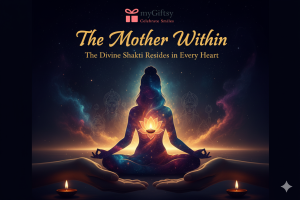
Ultimately, the deepest meaning of ‘Mata’ during Navratri is the realization that the divine feminine energy resides within all of us. The festival is a powerful reminder that we are all born of a mother and that the qualities of creation, nurture, and immense strength are inherent in the human spirit.
Navratri is not just about worshipping idols or deities; it is about honoring the ‘Mata’ within ourselves and in others. It’s a call to action to protect, nurture, and empower the feminine energy, which is essential for the balance of the world. It’s a time to celebrate our own inner strength, our capacity for compassion, and our ability to create and sustain life.
So, as we revel in the garba, wear colorful clothes, and light lamps, let’s remember that the “Navratri vibes” are not just external festivities—they are a deep, soulful celebration of the powerful and benevolent ‘Mata’ that lives in every heart.
